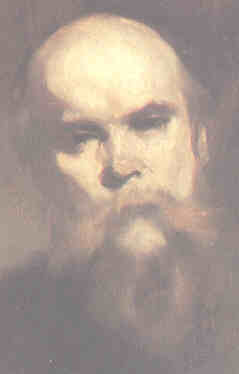 1844
Paul Verlaine, French lyric poet. ^top^ 1844
Paul Verlaine, French lyric poet. ^top^
Il meurt le 8 janvier 1896.
[Verlaine, 1891, par Eugène
Carrière (1849-1906) >]
1844 Le 30 mars, à Metz, naît Paul-Marie Verlaine. Sa mère, Elisa Dehée,
vient du Pas-de-Calais, alors que son père, le capitaine Nicolas-Auguste
Verlaine, est né au Luxembourg belge.
1851 La famille Verlaine vient s'installer à Paris.
1853 En octobre, Verlaine devient interne à l'Institution Landry, rue Chapsal,
à Paris.
1855 Tout en demeurant pensionnaire à l'Institution Landry, Verlaine suit
les cours du Lycée Condorcet, alors appelé Lycée Bonaparte.
1863 En avril, une œuvre de Verlaine, Monsieur Prud'homme qui sera
plus tard repris dans les Poèmes saturniens, est publié dans La
Revue du progrès moral, littéraire, scientifique et artistique. À cette
occasion, Verlaine connaît quelques poètes parnassiens. Pendant cet été-là,
il passe ses vacances à Lécluse, chez sa cousine, Élisa Moncomble, dont
il tombe amoureux.
1865 Le 1er janvier, Verlaine occupe un poste d'expéditionnaire à la préfecture
de la Seine. Cette année-là, il publie de nouveaux poèmes, notamment Nevermore.
1866 En avril, Le Parnasse contemporain publie sept poèmes de Verlaine
et, en novembre, Les Poèmes saturniens sont annoncés.
1867 À la fin de l'année, Poulet-Malassis, l'éditeur de Baudelaire, publie,
à Bruxelles, les poèmes des Amies.
1869 Les Fêtes galantes sont mises en vente. En juin, Verlaine
rencontre Mathilde Mauté et cette aventure amoureuse le hante toute l'année.
En juillet, le poète tente de tuer sa mère.
1870 La Bonne Chanson, le recueil qui relate l'évolution des sentiments
de Verlaine pour Mathilde Mauté, est publié en juin. Le mariage tant attendu
a lieu, à l'église Notre-Dame de Clignancourt, le 11 Aug.
1871 Verlaine commence l'année à Paris, malgré la Commune et l'ordre de
Thiers de quitter la capitale, puis de juin à août il se replie vers Fampoux
avec son épouse. En septembre, Verlaine fait venir Rimbaud à Paris. Les
poètes affichent des relations qu'on trouve scandaleuses. À la même époque,
Verlaine bat sa femme et la menace de mort. Le 30 octobre, Mathilde accouche
d'un garçon, Georges.
1872 L'année est marquée par de nombreux allers et retours de Verlaine entre
Rimbaud et Mathilde Mauté. Pour Verlaine, l'année se termine à Londres,
alors que Rimbaud vient de retourner en France. Mathilde Mauté, elle, entreprend
des procédures de séparation. Sur le plan de sa production poétique, l'année
est marquée, pour Verlaine, par la composition des Romances sans paroles,
sans doute son plus beau recueil.
1873 Le début de l'année est marqué par de nouvelles démêlées entre Verlaine,
Rimbaud et Mathilde Mauté. Verlaine menace de se tuer si Mathilde ne reprend
pas la vie commune. C'est le 10 Jul de cette année-là que Verlaine tire
deux balles de revolver sur Rimbaud. Le 08 Aug, le poète est condamné à
deux ans de prison. Il commence à purger sa peine à Bruxelles puis, en octobre,
il est transféré à la prison de Mons.
1874 En mars, Les Romances sans paroles sont enfin publiées. Le 24 Apr,
Verlaine apprend que la demande de séparation de Mathilde Mauté a été accordée.
En juin, Verlaine se dit converti. Vers cette date, il commence la composition
de Sagesse.
1875 En janvier, Verlaine est libéré. Il fréquente Rimbaud pendant quelques
jours à Stuttgart puis, au début d'avril, il trouve un emploi de professeur
de latin, de grec, de dessin et de français à la grammar school de Stickney.
1876 Verlaine enseigne maintenant au Collège Saint-Aloysius de Bournemouth.
1877-78 Verlaine achève une première version de Sagesse. En octobre 1877,
il devient professeur à l'Institution Notre-Dame de Rethel où, en 1878,
il s'éprend de Lucien Létinois, l'un de ses élèves. 1879 Verlaine est congédié
de l'Institution Notre-Dame. Il part alors vers l'Angleterre avec Lucien
Létinois. Celui-ci enseigne à Stickney, alors que Verlaine travaille au
Solent collegiate school de l'île de Wight.
1880 Au début de l'année, Verlaine achète une ferme à Juniville où il s'installe
avec Lucien Létinois. En novembre, Sagesse est publié à compte d'auteur.
1882 Verlaine vend sa ferme de Juniville et reprend contact, après dix ans
d'absence, avec les milieux littéraires parisiens.
1883 Lucien Létinois meurt de la typhoïde en avril. En juillet, Verlaine
s'installe avec sa mère à Coulombes, dans une ferme qu'ils achèteront aux
parents de Lucien Létinois. La vie qu'y mène Verlaine apparaît scandaleuse
au voisinage.
1884 En mars, Verlaine publie Les Poètes maudits, plaquette qu'il consacre
à Rimbaud, Mallarmé et Tristan Corbière. La même année, en novembre, il
publie Jadis et Naguère.
1885 En mars, Verlaine est condamné à un mois de prison suite aux coups
et aux menaces de mort commis sur sa mère. En juin, après une période de
vagabondage, il s'installe à Paris, dans un taudis, l'Hôtel du Midi.
1886-87 Le 21 janvier 1886, la mère de Verlaine meurt. Le poète est sans
le sou. Il passe la plus grande partie de cette année-là à l'hôpital, suite
à des ulcères qu'il a à la jambe. En 1887, les séjours de Verlaine à l'hôpital
sont de plus en plus nombreux et de plus en plus longs.
1888 Le 20 mars, Amour est mis en vente.
1889 Mise en vente, en juin, de Parallèlement.
1890-95 Cette période est marquée par de fréquents séjours à l'hôpital.
Verlaine publie anonymement Hombres (1890), un recueil sur les amours homosexuels.
Bonheur (1891) et Mes Prisons (1892) sont également publiés.
Le poète prononce d'assez nombreuses conférences, notamment en Hollande
(1892) et en Belgique (1893).
1896 Le 08 janvier, Verlaine meurt. Le 10 janvier, son cortège funèbre est
accompagné de milliers de personnes. Au cimetière des Batignolles, des discours
sont prononcés, notamment par Barrès, Coppée, Mallarmé et Moréas.
POÈMES
SATURNIENS Le premier recueil de Verlaine est aussi, cela n'a rien de
surprenant, celui où l'imitation de ses maîtres - Baudelaire, Hugo, Banville,
Leconte de Lisle — est la plus visible. Par exemple, la thématique
urbaine du créateur du Spleen de Paris transparaît dans Nocturne parisien,
alors que les rimes rares et le goût pour l'Orient caractéristiques de Banville
se retrouvent dans un poème comme Résignation. D'ailleurs, à l'époque de
la rédaction des Poèmes saturniens, soit vers 1865, Verlaine se réclamait
de l'art rigoureux et peu sentimental des Parnassiens. Cependant, ces sont
les pièces qui échappent le plus au credo parnassien qu'on retient d'abord
des Poèmes saturniens. Les demi-teintes de Nevermore, le bégaiement d'Un
rêve familier, les vers brefs de Chanson d'automne, voilà ce qui, dans ce
recueil de jeunesse, annonce le mieux ce que sera la voix de Verlaine. Ajoutons
enfin que l'allusion que le titre fait à Saturne renvoie à l'influence fatale
et au poids de la mélancolie que les astrologues associaient jadis à cette
planète.
FÊTES
GALANTES En février 1869, quand Verlaine publie les 22 pièces qui composent
Les Fêtes galantes, l'idée de se laisser inspirer par Fragonard, Boucher,
Watteau et, plus généralement, par les plaisirs qu'on associe au monde de
Louis XV n'est pas du tout neuve. De fait, Hugo, Gautier et Banville avaient
déjà, tout au long des années cinquante et soixante du XIXe siècle, favorisé
un regain d'intérêt pour une société et des artistes longtemps jugés artificiels
et superficiels. Dans La Gazette rimée et L'Artiste, deux revues où Verlaine
fait paraître en 1867 et 1868 quelques-uns des poèmes qu'il réunira bientôt
en recueil, la mode de Watteau et des personnages de la Commedia dell'arte
avait déjà été lancée, et cela bien avant que le poète des Romances sans
paroles n'y cède à son tour.
Dans
l'ensemble, les fêtes auxquelles nous convie Verlaine mettent en valeur
le plaisir dans ce qu'il a de plus sensuel: des pièces comme Sur
l'herbe ou En
bateau où les messieurs n'attendent que la noirceur pour se laisser
aller à leurs désirs le montrent bien, de même que les rêveries érotiques
de L'Allée ou ces promesses que pressentent les Ingénus.
La mélancolie n'a pas ici la lourdeur qu'elle prendra chez les Romantiques,
et quand on parle de mort, comme dans les Indolents,
il s'agit d'habitude de la petite mort qui suit la jouissance. Cependant,
la fantaisie qui domine l'ensemble du recueil prend nettement l'allure,
dans les pièces qui ferment Les Fêtes galantes, d'une tristesse
de plus en plus désespérée. En ce sens, le chant du rossignol qui termine
En sourdine relève d'une sensibilité et d'une esthétique (car, ici, la douleur
est à la fois poignante et belle) fort différentes de ce qu'on retrouvait
plus tôt dans le recueil.
Le style
de Verlaine est, dans Les Fêtes galantes, beaucoup plus souple que dans
Les Poèmes saturniens. Les vers sont parfois très brefs (cf. Colombine,
À Clymène),
la langue orale domine des poèmes comme Sur L'herbe ou Les
Indolents et, surtout, de nombreuses tournures familières (Verlaine
parle de culotte, de vertigo et emploie l'expression se pendant) et quelques
archaïsmes (faquins, céans, pensers) donnent une allure vive au recueil,
vivacité particulièrement bien adaptée au sujet. Davantage encore que dans
Les Poèmes saturniens, Verlaine se révèle ici un artiste qui maîtrise
parfaitement bien son outil, la langue française.
ROMANCES
SANS PAROLES Les quatre parties des Romances sans paroles ont été, selon
toute vraisemblance, composées entre le mois de mai 1872 et d'avril 1873.
Les
Ariettes oubliées, probablement écrites en mai et juin 1872, révèlent,
malgré les accents légers de la
sixième ariette, des sentiments tristes sans doute explicables
par la situation de Verlaine, déchiré entre son amour pour Rimbaud et l'attachement
qu'il éprouve encore pour sa femme, Mathilde Mauté, dont il venait tout
juste d'avoir un enfant. Les
Paysages belges, avec l'insistance qui y a été mise sur les couleurs,
les jeux de lumière et les décors fugaces, laissent percevoir l'influence
de l'Impressionnisme. Dans Birds
in the night, c'est du mariage de Verlaine avec Mathilde Mauté,
de l'échec de cette union surtout, qu'il est question. Enfin, les Aquarelles
peignent parfois des paysages londoniens, ce qui n'empêche pas leur créateur
— dans Green
et Child
Wife notamment- de rappeler encore une fois le souvenir de Mathilde.
Dans les Romances sans paroles, en particulier dans ses Ariettes
oubliées et Paysages belges, Verlaine se dégage de façon bien
plus radicale que dans ses recueils précédents de la tradition poétique.
De fait, dans ces deux sections, Verlaine a souvent recours aux vers impairs
et, au contraire de ce qu'exigent les règles de la prosodie, l'alternance
des rimnes masculines et féminines n'est pas systématiquement appliquée.
Dans les Paysages belges, d'ailleurs, Verlaine tord le cou à l'éloquence
et se concentre à capter l'instant dans ce qu'il a de plus fugitif, alors
que dans Beams
c'est l'exaltation devant la beauté que le poète exprime de la manière la
plus directe possible. Verlaine a longtemps voulu dédier ses Romances
sans paroles à Arthur
Rimbaud. Il va de soi que cela n'aurait été que justice, tant l'influence
du poète d'Une
Saison en enfer a été déterminante, et ce tout autant sur les sentiments
et les événements évoqués par Verlaine dans son recueil que sur la conception
de la poésie qui s'y est fait jour
LA
BONNE CHANSON La Bonne Chanson a été publié en juin 1870, soit
deux mois après le mariage de Paul Verlaine avec Mathilde Mauté. Toutes
les pièces du recueil ont d'abord été envoyées à la fiancée, ce qui fait
de ce petit livre la chronique romancée d'un amour qui finira, on le sait,
par sombrer dans la méchanceté et la mesquinerie. Les poèmes de La Bonne
Chanson - Verlaine les jugeait d'ailleurs ainsi - se caractérisent par leur
simplicité. Il ne faut pas, à ce propos, oublier que la première lectrice
de ces pièces n'avait que seize ans. Ainsi le style du recueil est bien
moins recherché que celui des Poèmes saturniens ou des Fêtes galantes: l'emploi
fréquent des rimes plates, d'alexandrins ou même de rimes telles amour/jour
(Verlaine a recours à cette rime à trois reprises) fait que la forme poétique
frôle parfois ici la banalité. Constamment dans le recueil, Verlaine vante
la sainteté (cf. VII)
et la sagesse (II,
III, VIII,
IX, XVIII)
de sa fiancée. Bien plus que la passion, c'est la raison et la rédemption
que le poète cherche. L'univers nocturne des Fêtes galantes est d'ailleurs
remplacé, dans La Bonne Chanson, par une atmosphère presque toujours lumineuse.
Verlaine a voulu aller contre sa nature la plus profonde et, en ce sens,
il n'est pas difficile de lire dans La Bonne Chanson le récit d'un cruel
malentendu dont à la fois Mathilde Mauté et Verlaine lui-même seront les
victimes.
SAGESSE
Ce recueil fut composé entre 1873 et 1880. Sa création fut, on le sait,
marquée par le séjour de Verlaine à la prison de Bruxelles (où il composa
notamment Le
ciel est par-dessus le toit... ), puis à celle de Mons. C'est de
cette époque que date le retour de Verlaine à la foi catholique. Cependant,
bien plus qu'un livre religieux, Sagesse exprime la difficulté
de Verlaine de s'extraire de ses vices (Les
faux beaux jours...), la soif de pardon (Les
chères mains...) et l'aspiration au calme (Le ciel est, par-dessus
le toit...). Par ailleurs, la confession à laquelle se livre Verlaine
ne doit pas nous faire négliger des pièces qui, comme L'échelonnement
des haies, renvoient au style épuré des Romances
sans paroles. Dans des poèmes comme ceux-là, Verlaine ne veut pas
nous convaincre, il n'essaie pas même de se confier: il suggère, simplement.
JADIS
ET NAGUÈRE Ce recueil, publié en 1884, est composé d'œuvres écrites,
pour la plupart, bien avant cette date, quelques-unes même ayant été créées
vers 1870. Ce livre rappelle donc parfois la veine des Fêtes galantes, mais
aussi l'aventure vécue avec Rimbaud (certains commentateurs rapprochent
ainsi Crimen
amoris d'Une
saison en enfer) ou les paysages hallucinés des Romances sans paroles
(cf. Kaléidoscope).
C'est aussi dans ce recueil qu'a été repris le poème de 1874,
Art poétique, où Verlaine exprime le plus explicitement ce
qui fait la beauté de son écriture. La rétrospective que constitue Jadis
et Naguère a été publiée à une époque où Verlaine, renié par les Parnassiens
de sa génération, est devenu l'un des hérauts du groupe qu'on appellera
les Symbolistes. Il est dommage seulement que ce livre qui aurait pu constituer
l'un des plus beaux du poète (des pièces comme Crimen amoris et Kaléidoscope
sont en effet superbes) ait été gonflé par des pièces plus insipides, comme
Les Uns et les Autres, comédie en vers qui a été assez artificiellement
intercalée à l'intérieur du recueil.
AMOUR
À l'origine, ce recueil devait compléter Sagesse, en équilibrant le thème
de la foi par celui de la charité chrétienne. Mais, peu à peu, d'autres
poèmes sont venus grossir le livre, l'éloignant de plus en plus de son plan
d'origine. De fait, à côté de pièces étroitement religieuses comme Bournemouth,
on retrouve des poèmes patriotes tels Gais
et contents ou d'inspiration populaire comme There.
Mais c'est surtout les vingt-quatre poèmes consacrés à la mémoire de Lucien
Lutinois, jeune paysan que Verlaine connut alors qu'il était professeur
et avec qui il habita pendant de nombreuses années, qui donnent une couleur
particulière à Amour. Il est vrai que certains poèmes, comme celui où Verlaine
absout Lucien Létinois d'avoir péché avec une jeune Anglaise, sont involontairement
loufoques, mais d'autres, tels J'ai
la fureur d'aimer ou L'affreux
Ivry, expriment une douleur authentique.
PARALLÈLEMENT
Comme Verlaine l'a lui-même écrit dans la préface de ce livre, ce recueil
a été écrit «parallèlement» à Sagesse
et à Amour.
De fait, alors que Sagesse exprimait la foi de Verlaine et que
plusieurs poèmes d'Amour ont été écrits sous l'effet de la morale
chrétienne, les pièces de Parallèlement abordent des sujets parfois
scabreux. De fait, la vertu bourgeoise — que Verlaine respectait encore
dans Amour — est mise à mal dans Les Amies (voir
là-dessus Printemps),
section où on retrouve un éloge des amours lesbiens, ou dans ces poèmes
de Filles (la seconde partie du recueil) dans lesquels Verlaine
se complaît dans le récit d'amours de bordels (voir Auburn).
Un poème comme Mains
évoque même l'image d'un assassin tant Verlaine sent son sens moral et son
goût pour la violence gonfler en lui. Il faut savoir là-dessus qu'entre
1885 et 1887, à l'époque où le poète prépare Parallèlement, il est réduit
au vagabondage ou, pire, il vit à l'hôpital. Parallèlement est donc une
composition née d'une des périodes les plus troubles de l'existence de Verlaine.
C'est aussi l'époque où il se désignait lui-même comme le pauvre Lélian.
|
Chanson d'automne
(Poèmes saturniens)
Les sanglots longs
Des violons
De l'automne
Blessent mon coeur
D'une langueur
Monotone.
Tout suffocant
Et blême, quand
Sonne l'heure,
Je me souviens
Des jours anciens
Et je pleure
Et je m'en vais
Au vent mauvais
Qui m'emporte
Deçà, delà,
Pareil à la
Feuille morte.
|
(Sagesse, 1881)
Le ciel
est, par-dessus le toit,
Si bleu, si calme !
Un arbre, par-dessus le toit,
Berce sa palme.
La cloche, dans le ciel qu'on voit,
Doucement tinte.
Un oiseau sur l'arbre qu'on voit
Chante sa plainte.
Mon Dieu, mon Dieu, la vie est là,
Simple et tranquille.
Cette paisible rumeur-là
Vient de la ville.
— Qu'as-tu fait, ô toi que voilà
Pleurant sans cesse,
Dis, qu'as-tu fait, toi que voilà,
De ta jeunesse ?
|
Nevermore
(Poèmes Saturniens, 1866)
Souvenir, souvenir, que me veux-tu ? L'automne
Faisait voler la grive à travers l'air atone,
Et le soleil dardait un rayon monotone
Sur le bois jaunissant où la bise détone.
Nous étions seul à seule et marchions en rêvant,
Elle et moi, les cheveux et la pensée au vent.
Soudain, tournant vers moi son regard émouvant :
« Quel fut ton plus beau jour ? » fit sa voix d'or vivant,
Sa voix douce et sonore, au frais timbre angélique.
Un sourire discret lui donna la réplique,
Et je baisai sa main blanche, dévotement.
— Ah ! les premières fleurs, qu'elles sont parfumées !
Et qu'il bruit avec un murmure charmant
Le premier « oui » qui sort de lèvres bien-aimées !
|
Il pleut doucement sur la ville
(Romances sans paroles, 1874)
Il pleure dans mon coeur
Comme il pleut sur la ville ;
Quelle est cette langueur
Qui pénètre mon coeur ?
Ô bruit doux de la pluie
Par terre et sur les toits !
Pour un coeur qui s'ennuie
Ô le chant de la pluie !
Il pleure sans raison
Dans ce coeur qui s'écoeure.
Quoi ! Nulle trahison ?...
Ce deuil est sans raison.
C'est bien la pire peine
De ne savoir pourquoi
Sans amour et sans haine
Mon coeur a tant de peine ! |

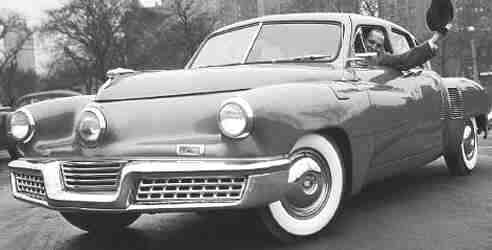
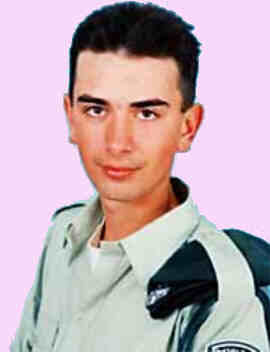
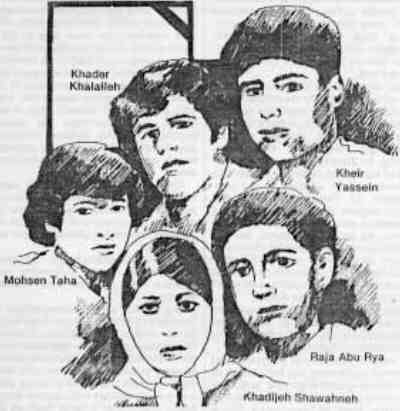 1976
Mohson Taha, 14, Raja Abu Rya, Khader Khalalieh, Kheir Yassein, Khadijeh
Shawahneh, Israeli Arabs killed by Israeli police.
1976
Mohson Taha, 14, Raja Abu Rya, Khader Khalalieh, Kheir Yassein, Khadijeh
Shawahneh, Israeli Arabs killed by Israeli police.

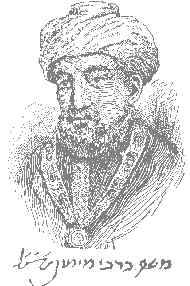 1135
1135